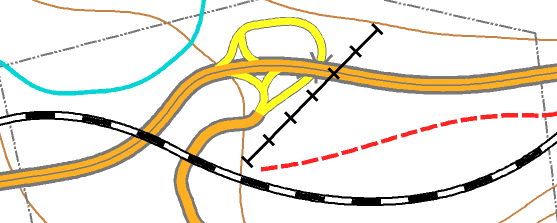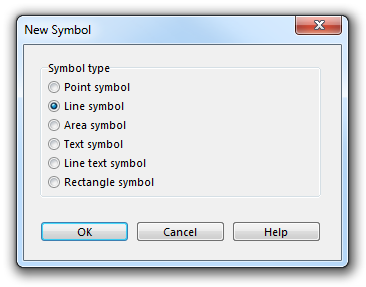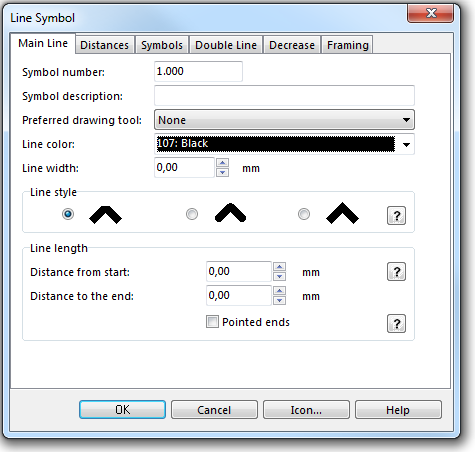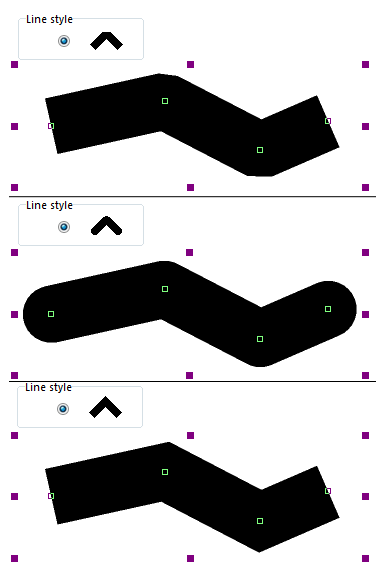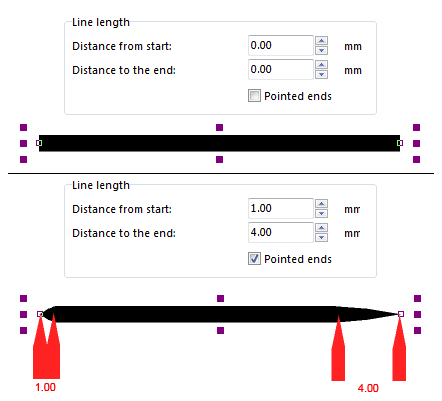Create a New Line Symbol
You can create very complex line symbols with OCAD. In addition, the symbol editor can make use of nearly all the drawing modes and editing tools that are available for objects in the normal drawing window to make a line symbol even more unique.
Choose the New command in the Symbol menu. Then, choose the Line Symbol option in the New Symbol dialog to create a new line symbol.
Line Symbol Dialog
The Line Symbol dialog appears. This dialog consists of six tabs:
- Main Line: Use this tab to define the color, line thickness and line type, generally the appearance of the main line.
- Distances: Use this tab to define the length of dashed lines and the distance between the dashes.
- Symbols: Use this tab to define the start, main, corner and end points.
- Double Line: Use this tab to define the line width, filling color, line thickness and line type of a double line.
- Decrease: In this tab a decreasing line type can be defined.
- Framing: With this tab you can use framing to cover other map objects if you use complex line symbols.
Main Line
In the Main Line tab you can make the following adjustments:
Symbol Number
Type a symbol number between 0.001 and 999999.999 in this field.
Symbol Description
Enter a symbol description in this field (e.g. Railway).
Preferred Drawing Tool
Choose a preferred drawing tool in the corresponding dropdown list. When the symbol is selected in the Symbol Box the drawing mode changes automatically to the chosen one. If None was chosen, the drawing mode remains the same as it was before.
Line Color
Choose a line color for the main line. The dropdown list contains all colors from the Color Table. If a main line is not used, it is not necessary to define a line color.
Line Width
If the symbol has a main line (full or dashed), enter a line width here. Type in 0.00 if you do not want to use a main line (e.g to create dotted lines).
Line Style
Choose between three line styles. The line ends and corners appear in each case differently.
Line Length
In this part of the dialog you can define two distances:
- Distance from start: This value defines the distance from the beginning of the line to the start of the main line (the start of the visible line).
- Distance to the end: This value defines the distance from the end of the visible line (main line) to the actual line end.
If you activate the Pointed ends option, the line gets pointed ends over the above mentioned distances.
Examples
- This is an example for a full line.
![]() Example Dashed Line with Background
Example Dashed Line with Background
- This is an example for the Distances from start and Distances to the end asjustments.
- This is an example for the Distances from start and Distances to the end asjustments.
- This is an example for a line with Pointed ends.
Distances
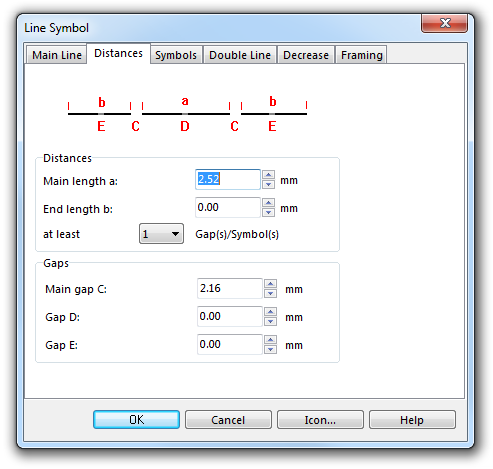
Distances
Main length a
This length defines the length of the main dash (see figure at the top of the dialog, the main dash is indicated with the letter a). For a dotted line, enter here the distance between the dots.
End length b
This length defines the length of the start and end dashes (see figure at the top of the dialog, the end dashes are indicated with the letter b). For a dotted line, enter 0 in this field to make sure, that the line starts with a dot and not a gap. For lines with dots on it, enter here the distance from the start of the line to the first dot on the line.
![]() The end length is also used before and after a corner of the line.
The end length is also used before and after a corner of the line.
at least X Gap(s)/Symbol(s)
Here you can define a minimum number (max 2) of gaps or symbols (if a main symbol is defined) that a line should contain. If you want a dashed line to always have a gap (regardless how short it is) then choose a 1 here.
Gaps
Main gap C
The value entered here defines the length of the main gap (see figure at the top of the dialog, the main gaps are indicated with the letter C).
Gap D
You can add an additional gap to the main dash. Define a length for it in this field (see also figure at the top of the dialog, the Gap D is indicated with the letter D).
Gap E
You can add an additional gap to the end dashes. Define a length for it in this field (see also figure at the top of the dialog, the Gap E is indicated with the letter E).
Examples
- This is an example for a dashed line with a main length of 2.0mm, an end length of 1.0mm and a main gap of 0.5mm.
- This is an example of a dotted line with a main length of 1.0mm.
- This is an example for a dashed line with a dot in the middle of each dash.
- Main gap C: For a dashed line, enter here the length of the gap; for other lines, enter here 0.
- Gap D: Define here a gap which appears between the main gaps or between the main symbols. (Note that the main symbol is where the main gap is). It is used in rare cases.
- Gap E: Define here a gap in the end part of the line. It is used in rare cases.
- Course setting symbol: Marked route
(This function is only available in course setting projects!) Activate this option if the symbol is used for marked routes.
- Area symbol: Symbol for area objects. Choose this page to define general parameters for the area symbol.
- Symbol no.: Enter here a number between 0.1 and 999'999.999 for the symbol. Each symbol in a given map requires a unique number.
- Description: Enter here a description for the symbol. The description is displayed when selecting the symbol or when selecting an object with that symbol.
- Preferred tool: Choose here a drawing mode. Each time the symbol is selected, the drawing mode changes to this drawing mode. Choose None to switch off this feature.
- Fill: Check this box if you want a filled area or a hatched/structured area with a background color. Choose here the color; otherwise this feature is not used. If the area is hatched/structured, make sure that the Fill color is below the colors of the other elements in the color table, otherwise the structure elements are covered by this color.
- Order: Check this box if you want a border line for the area symbol. Choose here an existing line symbol.
- Hatch/structure orientated to north
This setting is used when rotating a map (for instance between magnetic north and geographic north) using Rotate Map from the Map menu. Activate this option if the hatch or structure should remain in the same angle after the rotation. Deactivate this option if the hatch or structure should rotate.
Create a double line
Double lines are primarily used for streets, where you have a left and a right border line filled or not filled with another color. If you need a center line (often used for highways) define a main line (note that the color for the center line must be above the color for the infill in the color table).
Create a dashed double line
Mode
- Off: No side lines and no infill are drawn.
- Full lines: The left and the right side lines are full lines.
- Left line dashed: The right line is a full line and the left line is dashed.
- Both lines dashed: Both side lines are dashed.
- Width: Enter here the width between the sidelines (not including the sidelines).
- Fill: Check this box if you want to fill the space between the side lines.
Fill color: If Fill is checked select here the fill color. The advantage of a fill color is that street crossings are automatically cleared. To get that effect you must choose a fill color which is above the color of the side lines in the color table. Otherwise the infill cannot erase the side lines in the street crossings.
- Left line/Right line: Enter here a color and a line width for the side lines. Enter 0 if no side line should be drawn.
- Dashed: If you have chosen "Left line dashed" or "Both lines dashed" enter here the length of the dashes and the gap.
Define a framing line
Framing lines are normally used as a background to line objects. Often a framing line is used to block out (or cover) other objects. Note that the color of the framing line must be above the colors of the objects to be covered in the color table.
- Line color: Select the line color.
- Line width: Enter here the line width. Enter 0 here if no framing line should be drawn.
- Line style: Select one of the 3 line styles with different line ends and line joins.
Define a symbol witch decreases size
These features are primarily used for geological symbols with decreasing dots.
Decrease: Define here if the Symbols should decrease only towards one end or towards both ends.
Last symbol: Enter here how much the symbol size should decrease.
- Remark: The distance between the symbols is also decreased. However, the dashes of dashed lines are not decreased. Therefore you should not use the Decrease function together with dashed lines.
 Example Stone embankment top edge
Example Stone embankment top edge
Create special lines
